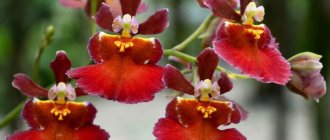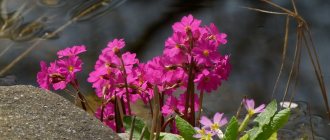There are flowers created by nature itself to cover the earth with a bright carpet. Among them is periwinkle, a photo of which clearly shows what such a living blanket looks like.
The flower is often used in landscape design, but it is also magnificent in home flower beds .
For its vitality and ability to thrive in the shade, periwinkle is considered one of the plants with magical powers.
general description
In Latin, the name of the plant sounds like Vinca, which means “creeping”. It belongs to the Kutrov family .
The main habitat is Europe and Asia, some species are found in North Africa. Popularly, periwinkle has succinct names: “witch’s violet”, “flower of love” .
It is a ground cover flower with leathery leaves. Depending on the variety and place of growth, they can be colored in light and dark green shades.
Today, varieties with variegated leaves have also been bred. Its flowers are simple in shape; the color scheme is dominated by lilac, blue, light blue and violet tones .
However, there are varieties, such as Periwinkle Burgundy Halo, with juicy red corollas.
Varieties
12 plant species have been found and studied in nature . Breeders added their contribution and presented flower growers with a large number of decorative varieties of periwinkle. We will tell you about the most common ones, providing you with photos and descriptions of plants.
Lesser periwinkle (Vinca minor)
The evergreen periwinkle has long, up to 1 meter, creeping stems, densely dotted with small green leaves. Its flowers are painted in all shades of blue.
Large (Vinca major)
The large periwinkle is the largest representative of the genus. The stem and leaves of the plant are covered with sparse hairs.
The length of the leaf blade varies from 3 to 9 cm. The diameter of the flower is 5 cm, the color is from light blue to dark purple. The middle of the flower is white.
Attention! Large periwinkle blooms from May to September with a short break.
Herbaceous (Vinca herbacea)
Herbaceous periwinkle is a deciduous plant species. It does not tolerate severe frosts well, so it needs reliable shelter for the winter.
It can often be found near roads and in oak groves. The stems of the flower cover the ground less frequently than those of the small periwinkle. Flowers can be blue, light blue or purple. Diameter - 3 cm. The main flowering time is May.
Pubescent (Vinca pubescens)
This type of flower lives in the western Caucasus and in the vast forests of Primorye. Loves open spaces.
It is fixed on the ground, spreading roots from creeping stems. The flowers are colored in various shades of blue.
Important! In winter he needs shelter.
Pink (Vinca rosea)
Pink periwinkle, or catharanthus, has been identified by scientists as a separate genus due to the large number of its species (8 pieces).
Unlike the large and small periwinkles, this species grows in bushes with erect stems. They can reach a height of 60 cm. The leaves are glossy, dark green, 7 cm in length.
Botanical characteristics
Periwinkle is a perennial with lodging or creeping branched shoots along the ground. It forms a spreading bush up to 35 cm high or a continuous green carpet. The roots are located horizontally, close to the surface of the earth. They grow up to 70 cm in length.
On thin stems covered with light green or reddish bark, opposite petiolate oval or ovoid leaves grow. Their dark green leathery surface glistens in the sun, and a lighter vein is visible in the center. The leaflets are 3-5 cm long and about 2.5 cm wide. Some species retain foliage throughout the year or shed it during unfavorable periods.
Flowering occurs in May-June. Large single flowers bloom in the axils of the leaves. The corolla with a long tube and five bent petals, separated along the edge, is about 3 cm in diameter. The stamens and ovary style only slightly peek out from the center. The petals are colored blue, purple or pink. Sometimes the shade saturation at the base and edge of the petals is different.
After pollination, the fruits ripen - sickle-shaped green leaves about 7-8 cm long. Inside them are elongated light brown seeds with a rough surface.
Indoor periwinkle
Some plant species are successfully cultivated at home. Indoor periwinkle is unpretentious, takes root well and looks impressive .
Among the domestic varieties, it is worth noting Periwinkle Sicily and Ampelous Periwinkle Pinot Noir .
Description
For home maintenance, shrub-type varieties with twining stems are chosen. Suitable for apartments and hanging periwinkle .
However, the entire decorative effect of the flower occurs in the summer; closer to winter, it sheds its leaves and takes on a sloppy appearance.
At this time, it is recommended to remove dried shoots so that the plant becomes lush and beautiful again in the spring.
Home care
The main thing in home care for periwinkle is moderate watering and protection from direct sunlight . The temperature during the growing season should be 23...25 °C.
In winter, 16...18 °C is enough. To maintain high humidity, the flower is sprayed. During flowering, spraying is stopped, but a container of water is placed next to it.
are used for feeding , adding them to the soil once every 2 weeks . The pot must have drainage to avoid stagnation of moisture.
Traditional recipes with periwinkle
For medicinal purposes, leaves and stems are collected during flowering. It is advisable to harvest roots at the end of summer. Well-developed shoots are cut by hand and laid out in a thin layer in the shade. To speed up the process, you can use a dryer. In this case, the maximum temperature should not be higher than +45°. Dried raw materials are better preserved in small bags made of natural fabric.
- From conjunctivitis. 6-8 flowers per liter of water is enough. Boil in a water bath for 15 minutes. Leave for 3 hours. Rinse eyes every 2 hours.
- For the treatment of various types of diabetes and lowering blood pressure. The same recipe, but with the addition of a few leaves. Take 2 tablespoons orally before meals.
- For anorexia, insomnia, depression. Add 100 grams of dry leaves to a liter of red wine. Leave to marinate for 10 days. Filter and take a couple of tablespoons before each meal.
Important! The sap of the plant is considered toxic. For any recipe there are a number of contraindications. We strongly recommend: do not take medications without a medical examination and a doctor’s recommendation.
Outdoor care
Planting and care in open ground, of course, are not similar to home procedures.
Owners have to take into account climatic conditions, the composition of the soil on the site, and the possibility of placing a cover plant in the landscape.
Lighting
Diffused lighting is suitable for periwinkle. If you keep a flower at home, choose western or eastern windows . For a plant planted in the garden, select a place with shade.
Lack of light can result in strong stretching of the shoots, which is why the flower will greatly lose its decorative value.
Temperature
Although periwinkle is native to warm regions of Europe and Asia, it does not tolerate much heat .
In summer, 23...25 °C is enough for him, but he also tolerates a drop to 20 °C normally. In winter, during the rest period, the temperature at home is kept around 16...18 °C.
Important! Open ground plants are simply reliably protected from snow.
Mulching
Mulching is a necessary procedure for periwinkle. It helps protect the soil from drying out, does not allow weeds to germinate in densely growing flower stems , freeing the owner from frequent weeding, and prevents freezing of the root system in winter.
As mulch, take small crumbs of pine bark 2–7 cm in size . The height of the mulch layer is 5–8 cm. Some gardeners, trying to make the planting more decorative, cover the ground under the periwinkle with small pebbles.
Humidity and watering
The moisture required for the plant is maintained by regular spraying . The water is settled and purified. The water temperature should be the same as the room or outdoor temperature.
The irrigation regime is set by coordinating it with several factors:
- variety requirements;
- weather;
- season;
- soil composition.
Water the flower early in the morning or in the evening.
Important! Periwinkle should not be watered when the sun is shining brightly: drops of water falling on the leaves refract the sun's rays, and the plant gets burned.
Watering plants of different ages also has its own characteristics.
Watering young seedlings
Young periwinkle shoots need abundant watering from the beginning of the growing season until mid-autumn . If the plants grow on sandy soil, they need constant irrigation.
Newly planted bushes are irrigated 3 times a week, then the irrigation is adjusted according to the weather.
Watering 1–4 year old plants
Plants that have reached the age of 1 year and older are watered according to the following scheme :
- in dry weather every 3–5 days;
- in rainy weather - once every 5–10 days, depending on the duration of the rains.
One bush requires 5–10 liters (depending on the size of the plant) per watering. Experienced gardeners arrange drip irrigation for flower carpets .
Important! Periwinkle should not be watered often and little by little, so as not to provoke the roots to emerge to the surface.
Watering mature plants
After 4 years of age, periwinkle is watered once a week in dry weather and once every 2 weeks on rainy days.
Watering periwinkle grown in containers
Bushes growing in containers are watered at the rate of 2–5 liters per plant in the same regime as plants planted in open ground.
Loosening the soil
If the periwinkle planting is not covered with mulch, you will have to constantly loosen the soil, while simultaneously removing weeds.
Transfer
Indoor periwinkle is replanted annually, thereby ensuring its lush flowering .
The new pot should be 2–3 cm larger in diameter. Before planting, the new container should be scalded with boiling water and filled with a layer of drainage.
Trimming
Periwinkle shoots grow quickly. If left unchecked, the blue carpet will fill your entire area.
In addition to the deterrent factor, pruning helps to rejuvenate the bushes , which has a positive effect on the lushness of the growth and its flowering. Pruning is done after the periwinkle has finished flowering.
The soil
The flower does not have any special requirements for the composition of the soil. The bushes can grow safely on weak and rocky soils, but it is best when the soil under the periwinkle is loose and well-drained .
Feeding
Humus, peat compost, urea - any of these fertilizers are beneficial for the plant and promote abundant flowering.
However, if the soil suits it, periwinkle will delight you with a thick carpet even without fertilizing .
Reproduction and transplantation of periwinkle
Vinca is propagated by dividing the bush, layering, cuttings, and seeds.
- The main condition when using the first two methods is seasonality. Both cuttings and division of the bush cannot be carried out while the periwinkle is blooming. Clone the plant either before or after this period.
- If you want to propagate cut branches, remove the lower leaves and plant them in pots with very moist soil. To speed up the rooting process, add stimulant preparations (Auxin, Novosil, Epin and others) to the irrigation water.
- Reproduction by layering is the easiest option. The side stems are pinned to the ground at 2-3 points and watered abundantly. After rooting, the stem is separated from the mother bush.
After flowering
After flowering, the periwinkle clearing does not lose its decorative effect, decorating the ground with a lush carpet.
The only thing that is required from the owner is to trim the protruding branches to give the planting a neat appearance . By the way, cut branches can be used as cuttings.
How and when to collect periwinkle seeds
Vinca flowering ends with the formation of seed pods. This usually happens in September. Considering that it blooms profusely and grows low, collecting seeds is long and difficult .
If you nevertheless decide to acquire seeds, carefully remove the boxes from the shoots, remove the seeds from them, dry them and put them in a fabric bag. Store in a cool and dry place .
Reproduction options
Vinca is propagated in several ways: cuttings, seeds, dividing the bush and fallen stems .
Lying stems
The simplest method that garden owners often resort to. In the spring, when the plant wakes up, the stems lying on the ground are pressed down and sprinkled with soil.
Rooting occurs in the fall, at which time the new shoot can be separated from the mother plant .
Dividing the bush
This option is more suitable for spring :
- a lush bush is dug out of the ground;
- disassembled into individual plants;
- Make separate holes for them and fill them with compost;
- new “tenants” are being planted.
Finish planting with abundant watering.
Cuttings
The traditional time for taking cuttings is spring . Early August is best for periwinkle. Cuttings taken at this time take root and take root faster and better. Step-by-step rooting of cuttings:
- Cut branches 10–15 cm long (1/3 of the shoot length) from strong and healthy bushes.
- Remove leaves from the bottom of the cutting.
- Dig a trench in the area and fill it with moist nutrient soil.
- Plant the cuttings, deepening them so that the part with three leaves is above the surface.
- Provide regular watering.
It takes a month for the root system to develop. Then the planting is disassembled, planting new plants in separate holes at a distance of 30 cm from each other .
If planting was carried out in early August, the seedlings must be carefully covered with dry leaves for the winter so that they do not die.
Seeds
When growing seedlings in winter, it is better to use flower pots . In this case, you will have plants as indoors.
Caring for them at home is normal. In the spring, the periwinkle will only need to be planted in a permanent place.
Periwinkle seeds can be sown from spring to autumn. By planting in the spring, you will receive seedlings by the beginning of summer and will be able to transfer them to open ground. Autumn planting of seeds for seedlings is designed to produce seedlings that are planted in the garden in the spring.
Before planting, seeds . When deepening them into the soil, distribute them so that there is 20–25 cm between the seeds. Be sure to mulch the soil under the seedlings so that it does not dry out.
Growing Periwinkle from seeds
It is convenient to grow periwinkle by seeds - you can plant it directly into the ground in May-early June, in stable warm weather or in late autumn, and you can also plant seeds for seedlings. As for the winter method of sowing seeds, it is necessary to calculate the time in such a way that the young shoots do not die in the first frosts. To do this, you just need to make the furrows deeper and cover the plantings with straw mulch. What else can be used as mulch can be found in this article.
The plant will thrive in loose and nutritious soil with neutral Ph. To improve the condition of the soil, humus and peat are added. Planting areas should be chosen with light shade; this choice will be the best option. The flower grows well in both very sunny and heavily shaded areas. In areas with light shade, Periwinkle looks especially beautiful, as its leaves acquire a particularly rich green color.
When planting seeds directly in open ground, Periwinkle grows only in the second year.
To sow seeds in the ground, prepare dug-up fertilized beds. On the leveled surface of the earth, make shallow grooves (1.5-2 cm) and sprinkle a few seeds. Level and moisten the soil. To accelerate the growth of flowers, you can add fertilizers diluted ten times the norm, containing nitrogen, potassium and phosphorus. Germination can be expected within 7-10 days.
Diseases and pests
The main enemy of periwinkle is aphid . She happily settles on the dense and low growths of the flower, destroying its leaves and stems.
You can fight aphids with insecticides, but first you need to remove all affected parts of the plant.
If powdery mildew , spray the flower with a soap solution. Rust is removed using special means.
You ask - we answer
What is periwinkle in Russian?
Periwinkle in Russian is a beautiful wreath. The word is of Ukrainian origin. According to legend, this plant is considered a symbol of love, fidelity and eternal memory.
Are catharanthus and periwinkle the same thing?
Catharanthus rosea belongs to the Kutrov family, and until the middle of the last century it was classified as a variety of periwinkle, then separated into a separate genus of perennials.
Are there any disadvantages to growing periwinkle?
If it doesn’t bother you that people call this plant a grave flower, since it is often planted in cemeteries, then only one of the minuses can be significant - periwinkle grows quite quickly in different directions, and if you don’t cut off the loops in time, the flower cloth will take up a large square.
Use in landscape design
Periwinkle in landscape design is attractive due to its ability to grow in shaded areas. It is often used to decorate space under large trees . It is also suitable for improving and strengthening slopes on the site.
Vinca is planted in flower beds together with bulbous plants . Alpine slides also decorate it with a thick carpet. The variegated appearance of the plant looks especially impressive in such a composition. This is what periwinkle looks like in landscape design (photo).
Periwinkle in the garden landscape
Gardeners value it as a shade-tolerant ground cover plant and use it in arranging flower beds, alpine slides, and compositions with stones. Looks great next to primroses such as scillas, crocuses and snowdrops, as well as primroses, forget-me-nots and hyacinths. Can be planted under rose hips or rose bushes. Periwinkle greens will highlight their colorfulness.
Periwinkle in the garden landscape
The climbing stems make original hedges up to one and a half meters high. They grow quickly, add beauty to the yard, and are durable. It is easy to care for a green fence: you just need to water it and trim it on time.
A winning option is to plant periwinkle, masking unkempt and unsightly areas of the yard or cottage. It will advantageously decorate the garden space and become an attractive yard decoration.
0 0 votes
Article rating
Properties of periwinkle
The healing power of periwinkle has been known since ancient times. Traditional healers used the plant in the treatment of skin diseases, for healing wounds, and against tuberculosis .
In the famous computer game "Stalker" the drug from periwinkle acts as a hemostatic agent.
Interesting! In Germany, wreaths were woven from periwinkle branches and hung on the door of the house to protect it from dark forces.
Medicinal properties
In modern pharmacology, alkaloids isolated from vinca are actively used . They are included in drugs that help with:
- cerebrovascular accidents;
- thinning of blood vessels;
- prevention of ischemia, atherosclerosis;
- asthma.
Contraindications
Every medicinal plant has benefits and harms . In the case of periwinkle, we must remember that at increased doses its alkaloids negatively affect the functioning of the heart.
Contraindications to drugs with periwinkle indicate that they cannot be used by pregnant women at all stages of gestation.
In addition, infusions and decoctions prepared at home should be taken with caution , because vinca is a poisonous plant. An error in the recipe can lead to serious problems.
A perennial with evergreen leaves that can grow in the shade, it attracts the attention of gardeners. We love them for their lush flowering. The flower fits well into the home interior .
Vinca does not require much care, it reproduces well, the main thing is to choose the variety that you like best.











